Swedish Consumers’ Perception of Food Quality and Sustainability in Relation to Organic Food Production
Abstract
:1. Introduction
2. Methodology
2.1. Data Survey
2.2. Hypothesis Based Analysis
3. Results and Discussion
3.1. Demographic Characteristics of Organic Food Consumers in Sweden
3.2. Consumers Perception on Sustainable Food Production
- ➢
- Sustainability in agriculture is a vague concept and depends on geographical location of production and product type;
- ➢
- In both organic and conventional food production approaches, sustainability could depend on how well the methods are used;
- ➢
- At present, both organic and conventional methods are not sustainable, especially from an economic and social point of view;
- ➢
- Sustainability is an advanced concept and more expert knowledge is needed to decide.
3.2.1. Relation between Gender Difference and Perceptions of Sustainable Food Production System
3.2.2. Relation between Consumers’ Age and Perception of Sustainable Food Production
3.2.3. Relation between Education Level and Perceptions towards Sustainable Food Production Methods
3.2.4. Relation between Household Size and Attitudes towards Sustainable Farming Methods
3.2.5. Relation between Income Level and Perceptions of Sustainable Food Production
3.3. Evaluation of Food Quality
3.3.1. Analyzing How Consumers Evaluate Food Quality
3.3.2. Relationship between Consumers’ Income Level and their Evaluation of Food Quality
3.4. Evaluation of Food Buying Decision
3.4.1. Analyzing the Trend of Consumers’ Food Buying Decisions
3.4.2. Relation between Consumers’ Income Level and Their Food Buying Decisions
3.5. Relationship between Consumers Perceptions of Food Quality and Their Buying Decisions
3.6. Purchasing Characteristics and Expenditure on Organic Food
3.7. Further Discussion and Recommendation
- Increasing the supply of regionally produced and organic food and food raw materials as well as increasing traceability for both locally produced and imported organic products is important to increase consumers’ satisfaction in Sweden.
- Promoting further study, especially targeting consumers such as the LOHAS group who are more interested in organic and regional food produced in a sustainable way. This helps to identify more specific demands and characteristics of organic food consumers with adequate scientific data, because, these group of consumers are expected to be more willing to participate in the data survey for studies to be conducted on organic food and sustainable food production.
- Further studies on consumers are needed to build a good knowledge base in relation to promoting sustainable food production. Those new studies should focus on balanced means of data collection, for instance telephone contact, face-to-face interview, and online responses.
4. Conclusions
Acknowledgments
Author Contributions
Conflicts of Interest
References
- Röös, E.; Karlsson, H. Effect of eating seasonal on the carbon footprint of Swedish vegetable consumption. J. Clean. Prod. 2013, 59, 63–72. [Google Scholar] [CrossRef]
- European Parliamentary Research Service (EPRS). Short Food Supply Chains and Local Food Systems in the EU. Available online: http://www.europarl.europa.eu/RegData/etudes/BRIE/2016/586650/EPRS_BRI(2016)586650_EN.pdf (accessed on 20 November 2017).
- Organic Farming. Available online: https://enrd.ec.europa.eu/publications/eu-rural-review-18-organic-farming_en (accessed on 26 March 2018).
- Arbenz, M.; Gould, D.; Stopes, C. The World of Organic Agriculture: Statistics and Emerging Trends; Research Institute of Organic Agriculture FiBL and IFOAM-Organics International: Goesan County, Switzerland, 2016; Available online: https://shop.fibl.org/CHde/mwdownloads/download/link/id/747/?ref=1 (accessed on 26 March 2018).
- EC. Council Regulation (EC) No. 834/2007 of 28 June 2007 on Organic Production and Labelling of Organic Products and Repealing Regulation (EEC) No. 2092/91. Off. J. Eur. Union 2007. Available online: http://extwprlegs1.fao.org/docs/pdf/eur72928.pdf (accessed on 26 March 2018).
- United Nations General Assembly. Report of the World Commission on Environment and Development: Our Common Future; Development and International Co-Operation: Environment; United Nations General Assembly: Oslo, Norway, 1987. [Google Scholar]
- EISA (Undated). A Common Codex for Integrated Farming; European Initiative for Sustainable Development in Agriculture (EISA): Bonn, Germany.
- KRAV. Market Report 2016. Report of KRAV. 2016. Available online: http://www.krav.se/sites/default /files/krav_market_report_2016_eng_webb.pdf (accessed on 2 January 2017).
- Jönsson, Å.H. Organic Apple Production in Sweden: Cultivation and Cultivars. Ph.D. Thesis, Swedish University of Agricultural Sciences, Alnarp, Lomma, Sweden, 2007. [Google Scholar]
- KRAV. Standards for KRAV-Certified Production. The KRAV Association, 2018. Available online: http://www.krav.se/sites/default/files/krav_standards_2018.pdf (accessed on 12 January 2018).
- Ajzen, I. Consumer Attitudes and Behavior. In Handbook of Consumer Psychology; Haugtvedt, C.P., Herr, P.M., Cardes, F.R., Eds.; Lawrence Erlbaum Associates: New York, NY, USA, 2008; pp. 525–548. [Google Scholar]
- Billing, V.; Mikk, M.; Airi, A. Local and Organic Food. EU INTERREG IIIC Project 2005–2007. 2007. Available online: http://www.interreg4c.eu/uploads/media/pdf/7_Local_and_Organic_Food_LOF.pdf (accessed on 12 February 2017).
- Hilmkvist, N. Is Organic Greenhouse Production of Tomato in Scania feasible? Experiences and Reflections According to Swedish Growers in Scania. Master’s Thesis, University of Lund, Lund, Sweden, September 2015. [Google Scholar]
- Kumar, B.; Manrai, A.K.; Manrai, L.A. Purchasing behavior for environmentally sustainable products: A conceptual framework and empirical study. J. Retail. Consum. Serv. 2017, 34, 1–9. [Google Scholar] [CrossRef]
- Tjärnemo, H.; Södahl, L. Swedish food retailers promoting climate smarter food choices-trapped between visions and reality? J. Retail. Consum. Serv. 2015, 24, 130–139. [Google Scholar] [CrossRef]
- Ngobo, P.-V.; Jean, S. Does store image influence demand for organic store brands? J. Retail. Consum. Serv. 2012, 19, 621–628. [Google Scholar] [CrossRef]
- Food and Agriculture Organization of the United Nations. World Markets for Organic Fruit and Vegetables: Opportunities for Developing Countries in the Production and Export of Organic Horticultural Products; Food and Agriculture Organization of the United Nations: Rome, Italy, 2001. [Google Scholar]
- Szakály, Z.; Popp, J.; Kontor, E.; Kovács, S.; Petö, K.; Jasák, H. Attitudes of the Lifestyle of Health and Sustainability Segment in Hungary. Sustainability 2017, 9, 1763. [Google Scholar] [CrossRef]
- Irandoust, M. Modelling Consumers’ Demand for Organic Food Products: The Swedish Experience. Int. J. Food Agric. Econ. 2016, 4, 77–89. [Google Scholar]
- Magnusson, M.K.; Arova, A.; Hursti, U.K. Attitudes towards organic foods among Swedish consumers. Br. Food J. 2001, 103, 209–226. [Google Scholar] [CrossRef]
- FAO. Organic Agriculture. In Proceedings of the Committee on Agriculture, Rome, Italy, 25–29 January 1999; Available online: http://www.fao.org/docrep/meeting/X0075e.htm#P86_4004 (accessed on 20 October 2016).
- Shafie, F.A.; Rennie, D. Consumer Perceptions towards Organic Food. Procedia Soc. Behav. Sci. 2012, 49, 360–367. [Google Scholar] [CrossRef]
- Basha, M.B.; Masonb, C.; Shamsudin, M.F.; Hussain, H.I.; Salem, M.A. Consumers Attitude towards Organic Food. Procedia Econ. Financ. 2015, 31, 444–452. [Google Scholar] [CrossRef]
- Brul, P.; Mattsson, E.; Parrott, N.; Stopes, C. Organic Food and Farming for All; Project Report, Green Action Week 2013 and 2014; Swedish Society for Nature Conservation: Stockholm, Sweden, 2013; ISBN 978-91-558-0115-1. [Google Scholar]
- Oroian, C.F.; Safirescu, C.O.; Harun, R.; Chiciudean, G.O.; Arion, F.H.; Muresan, I.C.; Bordeanu, B.M. Consumers’ Attitudes towards Organic Products and Sustainable Development: A Case Study of Romania. Sustainability 2017, 9, 1559. [Google Scholar] [CrossRef]
- Mutlu, N. Consumer Attitude and Behavior towards Organic Food: Cross-Cultural Study of Turkey and Germany. Master’s Thesis, Institute for Agricultural Policy and Markets, Hohenheim University, Stuttgart, Germany, October 2007. [Google Scholar]
- Petrescu, A.G.; Oncioiu, I.; Petrescu, M. Perception of Organic Food Consumption in Romania. Foods 2017, 6, 42. [Google Scholar] [CrossRef] [PubMed]
- Stolz, H.; Stolze, M.; Hamm, U.; Janssen, M.; Ruto, E. Consumer attitudes towards organic versus conventional food with specific quality attributes. NJAS Wagening. J. Life Sci. 2011, 58, 67–72. [Google Scholar] [CrossRef]
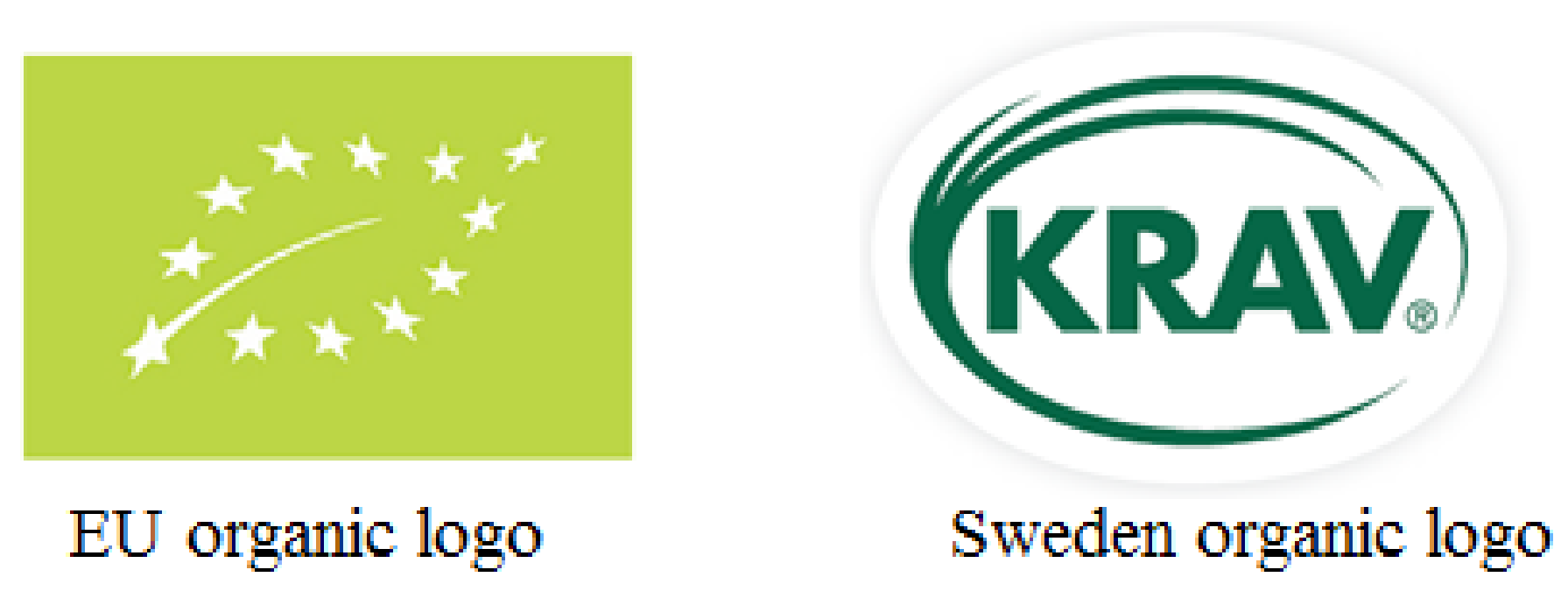
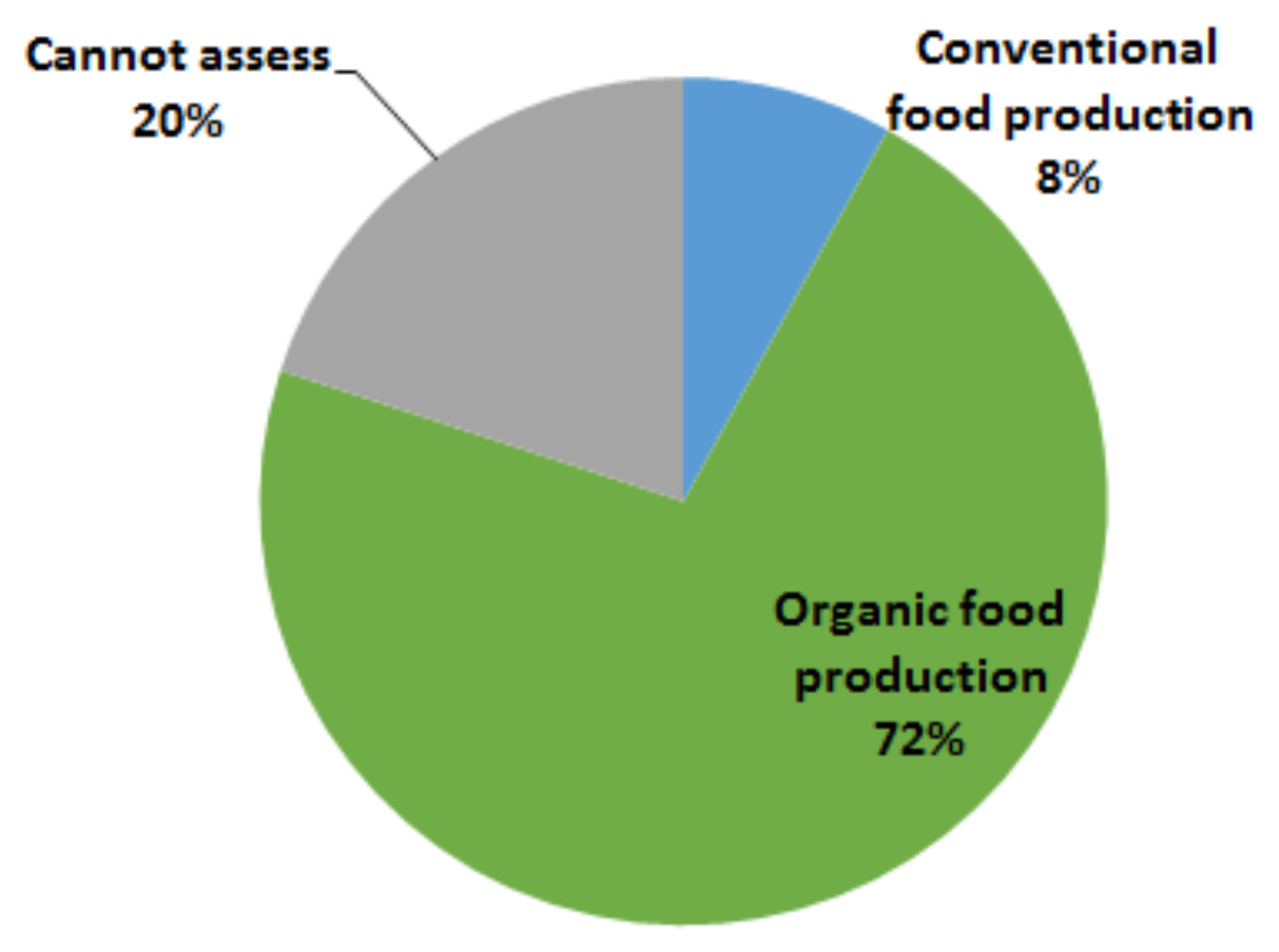
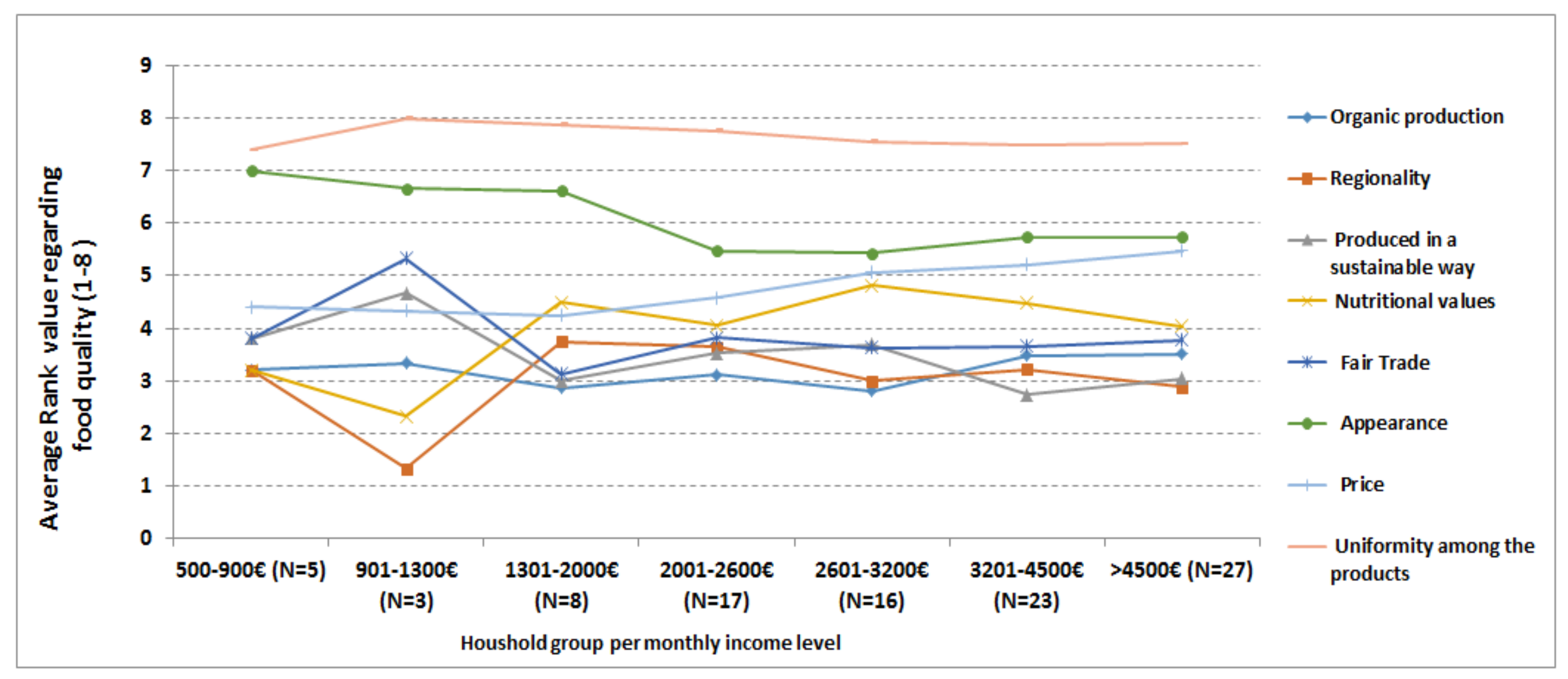
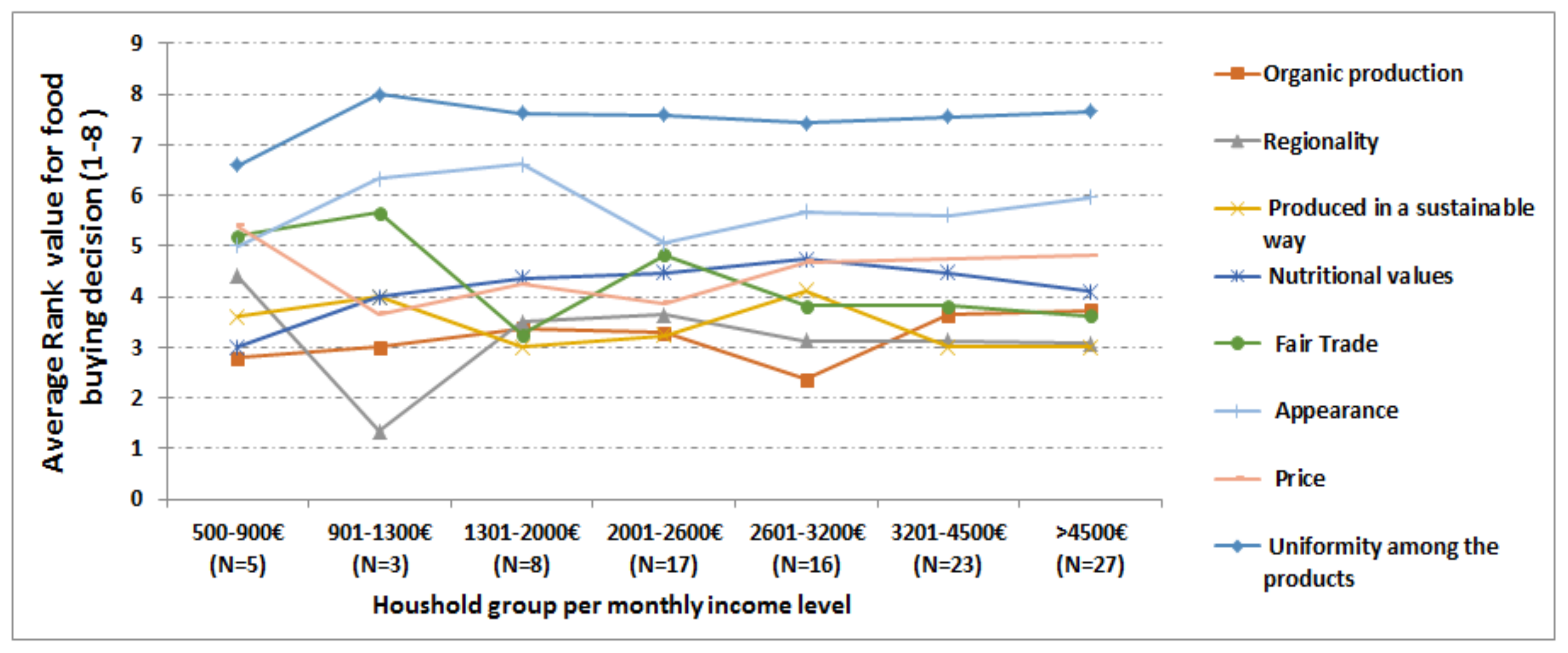
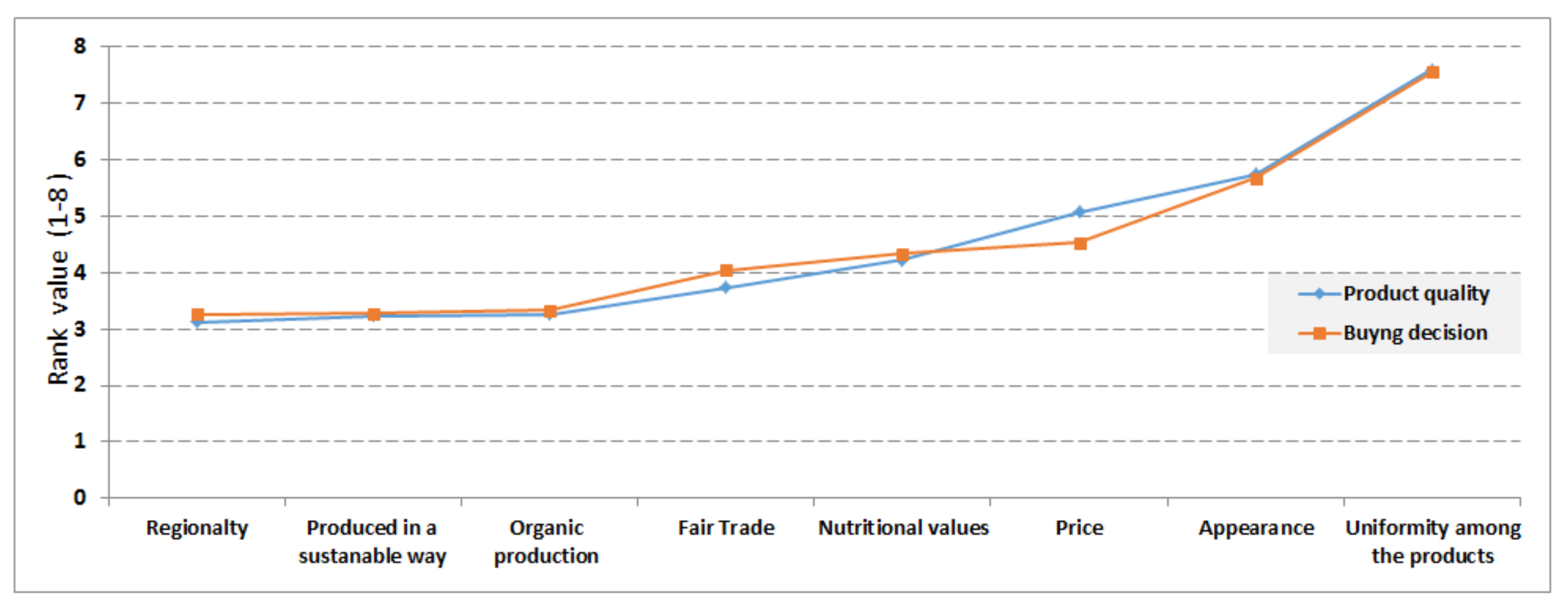
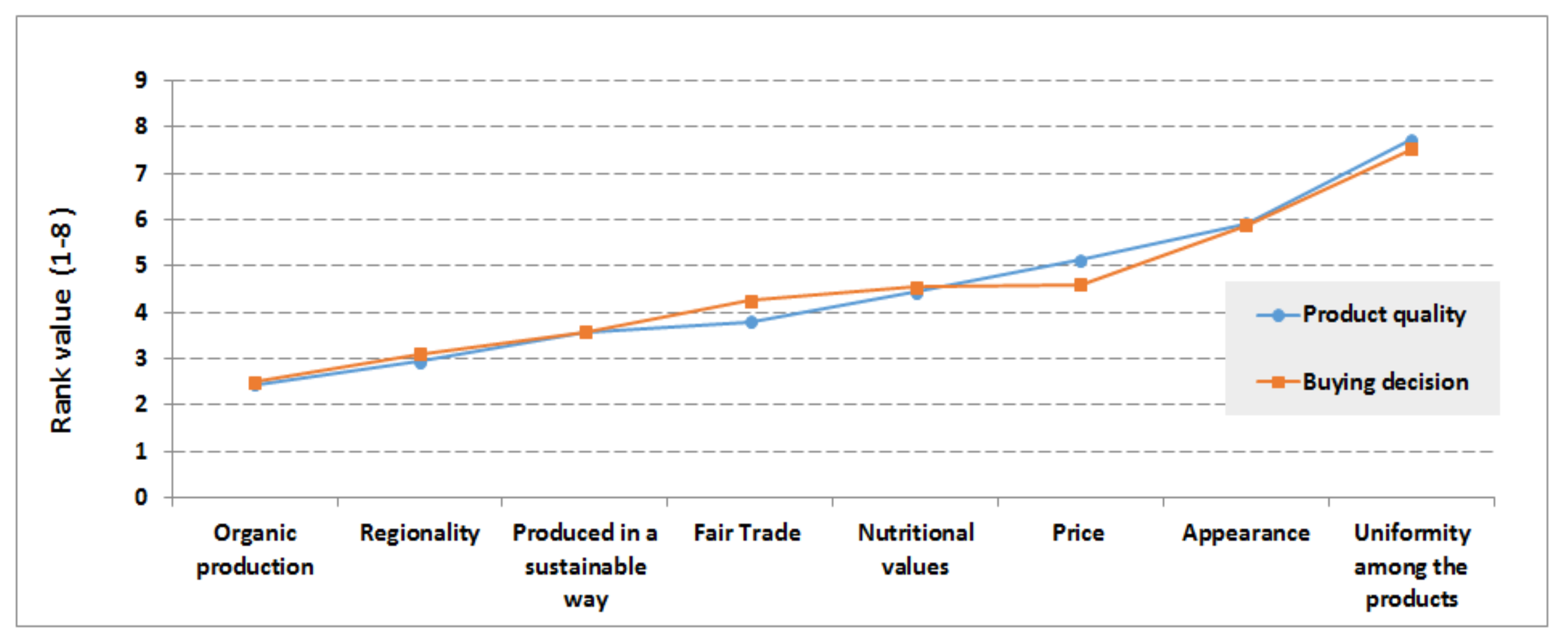
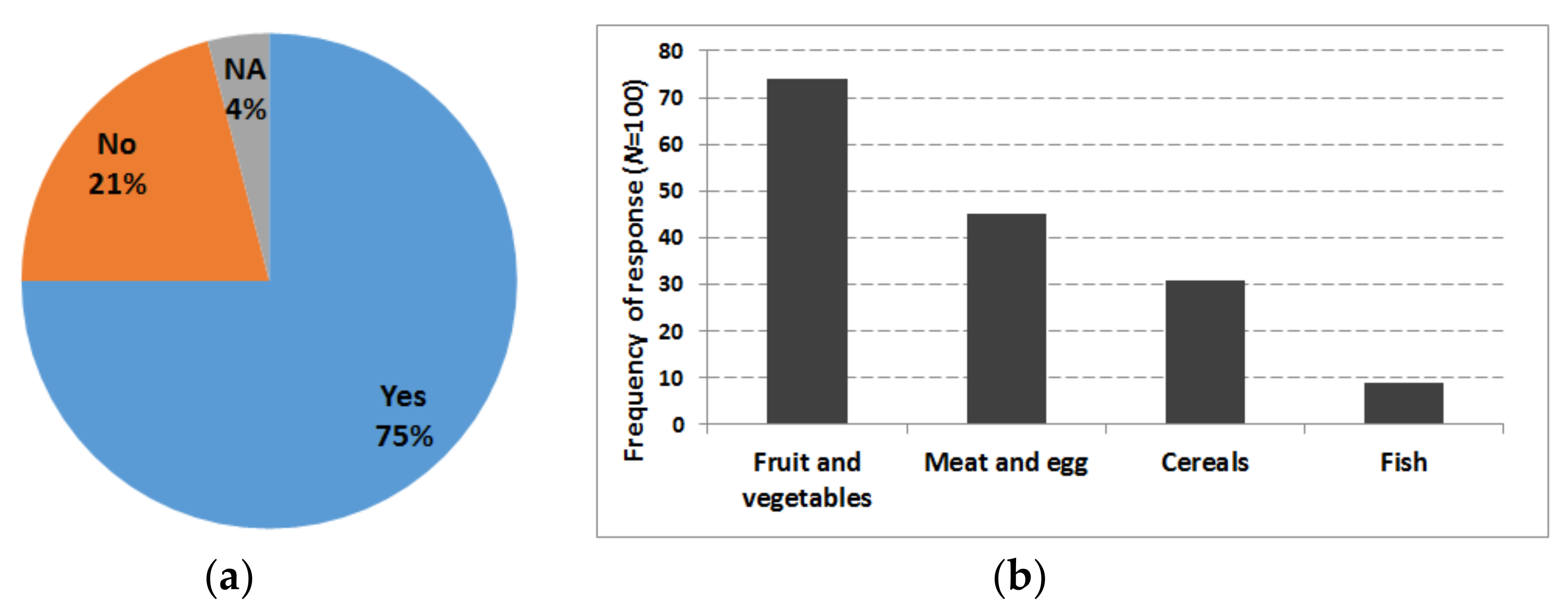
| Variables under Comparison | Null Hypothesis (Ho) |
|---|---|
| Relation between gender difference and perception of sustainable food production system | Hypothesis 1. Perception of sustainable food production method does not depend on gender difference. |
| Relation between consumers’ age and perception of sustainable food production | Hypothesis 2. Age difference and perception regarding sustainable method of farming are independent. |
| Relation between education level and perception towards sustainable food production methods | Hypothesis 3. Education status and perception regarding more sustainable farming method are independent. |
| Relation between household size and attitude towards sustainable farming methods | Hypothesis 4. Perception of consumers of sustainable food production system does not depend on household size. |
| Relation between income level and perception of sustainable food production | Hypothesis 5. Participants’ income levels and perception of sustainable farming methods are independent. |
| Relationship between consumers’ income level and their evaluation of food quality | Hypothesis 6. Food quality characterization by consumers does not depend on their income level. |
| Relation between consumers’ income level and their food buying decision | Hypothesis 7. Consumers’ food buying decision does not depend on their income level. |
| Demographic Characteristics | Variable | Number of Participants | Total |
|---|---|---|---|
| Gender | Male | 39 | 100 |
| Female | 61 | ||
| Age | 18–24 | 4 | 100 |
| 25–34 | 15 | ||
| 35–44 | 32 | ||
| 45–54 | 22 | ||
| 55–64 | 17 | ||
| 65+ | 10 | ||
| Education level | Primary education | 1 | 100 |
| Lower secondary education | 2 | ||
| Upper secondary education | 6 | ||
| University education | 86 | ||
| Vocational education | 5 | ||
| Household income (€/month) | 500–900 | 5 | 100 |
| 901–1300 | 3 | ||
| 1301–1500 | 1 | ||
| 1501–1700 | 0 | ||
| 1701–2000 | 7 | ||
| 2001–2600 | 17 | ||
| 2601–3200 | 16 | ||
| 3201–4500 | 23 | ||
| ≥4500 | 27 | ||
| can’t answer | 1 | ||
| Number of family members | 1 | 19 | 100 |
| 2 | 38 | ||
| 3 | 17 | ||
| 4 | 19 | ||
| ≥5 | 7 | ||
| Occupation | Employee or running own business | 79 | 100 |
| No job (searching for job) | 2 | ||
| Student | 6 | ||
| Pensioner | 12 | ||
| other (no data) | 4 | ||
| Number of children per household | No child | 54 | 100 |
| <5 years old | 14 | ||
| 5–14 years old | 28 | ||
| 14–18 years old | 4 |
| Perceived Sustainable Food Production | Major Arguments Indicated |
|---|---|
| Organic production | Avoiding use of chemicals, less toxins, and improving animal husbandry |
| Nutrient cycles and less chemicals | |
| Better conditions for environment and animals | |
| Organic farming has environmental and ecosystem protection mindset | |
| Better preservation of biodiversity, small-scale farming and important cultural sites | |
| Organic farming ensures food for future generation i.e., Less exploitation of resources | |
| Organic farming requires less investment fund | |
| Less chemical; locally produced | |
| Organic farming avoids genetically modified organisim (GMOs) | |
| Organic products have good taste and food quality | |
| Conventional production | Organic farming disregards importance of using GMO |
| No convincing scientific reason for organic farming being better than conventional | |
| Organic cannot feed growing demand of increasing population | |
| Depending on country conventional farming can be sustainable e.g., some of participants believe that Swedish conventional farming is sustainable | |
| Conventional farm needs less land (and less leaking of nutrients in relation to production) than organic farming | |
| Conventional farming is more free from disease infestation | |
| There are more restrictions on organic farming. That can hinder it from being sustainable | |
| Cannot assess (difficult to judge) | It depends on how well methods used in both cases Sustainability is a vague concept and depends on geographical location of production and product type |
| More expert knowledge needed to decide | |
| Both organic and conventional methods are not sustainable at present e.g., From an economic and social point of view |
| Gender | Organic Farming | Conventional Farming | Cannot Assess * | Total |
|---|---|---|---|---|
| Male | 21 | 6 | 12 | 39 |
| Female | 51 | 2 | 8 | 61 |
| Total | 72 | 8 | 20 | 100 |
| Chi-square test parameters | df ** | 2 | ||
| p | 0.004 |
| Age | Organic Farming | Conventional Farming | Cannot Assess | Total |
|---|---|---|---|---|
| 18–24 | 4 | 0 | 0 | 4 |
| 25–34 | 11 | 1 | 3 | 15 |
| 35–44 | 23 | 2 | 7 | 32 |
| 45–54 | 18 | 0 | 4 | 22 |
| 55–64 | 12 | 1 | 4 | 17 |
| 65+ | 4 | 4 | 2 | 10 |
| Total | 72 | 8 | 20 | 100 |
| Chi-square test parameters | df | 10 | ||
| p | 0.0503 |
| Education Status | Organic Farming | Conventional Farming | Cannot Asses | Total |
|---|---|---|---|---|
| Primary school education | 0 | 1 | 0 | 1 |
| High school education—incomplete | 2 | 0 | 0 | 2 |
| High school education—complete | 5 | 0 | 1 | 6 |
| Higher education—Vocational training | 5 | 0 | 0 | 5 |
| Higher education—University education | 60 | 7 | 19 | 86 |
| Total | 72 | 8 | 20 | 100 |
| Chi-square test parameters | df | 8 | ||
| p | 0.057 |
| Household Size | Organc Production | Conventonal Production | Cannot Asses | Total |
|---|---|---|---|---|
| 1 | 13 | 2 | 4 | 19 |
| 2 | 27 | 4 | 7 | 38 |
| 3 | 14 | 1 | 3 | 18 |
| 4 | 15 | 0 | 4 | 19 |
| ≥5 | 3 | 1 | 2 | 6 |
| Total | 72 | 8 | 20 | 100 |
| Pearson’s Chi-square test parameters | df | 8 | ||
| p | 0.86 |
| Perceived Sustainable Production Method | Monthly Income Range | ||||||||
|---|---|---|---|---|---|---|---|---|---|
| 500–900 € | 901–1300 € | 1301–2000 € | 2001–2600 € | 2601–3200 € | 3201–4500 € | >4500 € | Cannot Decide | Total | |
| Conventional | 1 | 0 | 0 | 1 | 0 | 3 | 3 | 0 | 8 |
| Organic | 4 | 3 | 6 | 15 | 13 | 14 | 16 | 1 | 72 |
| Do not know | 0 | 0 | 2 | 1 | 3 | 6 | 8 | 0 | 20 |
| TOTAL | 5 | 3 | 8 | 17 | 16 | 23 | 27 | 1 | 100 |
| Pearson’s Chi-Square test | df | 14 | |||||||
| p | 0.62 | ||||||||
© 2018 by the authors. Licensee MDPI, Basel, Switzerland. This article is an open access article distributed under the terms and conditions of the Creative Commons Attribution (CC BY) license (http://creativecommons.org/licenses/by/4.0/).
Share and Cite
Bosona, T.; Gebresenbet, G. Swedish Consumers’ Perception of Food Quality and Sustainability in Relation to Organic Food Production. Foods 2018, 7, 54. https://doi.org/10.3390/foods7040054
Bosona T, Gebresenbet G. Swedish Consumers’ Perception of Food Quality and Sustainability in Relation to Organic Food Production. Foods. 2018; 7(4):54. https://doi.org/10.3390/foods7040054
Chicago/Turabian StyleBosona, Techane, and Girma Gebresenbet. 2018. "Swedish Consumers’ Perception of Food Quality and Sustainability in Relation to Organic Food Production" Foods 7, no. 4: 54. https://doi.org/10.3390/foods7040054
APA StyleBosona, T., & Gebresenbet, G. (2018). Swedish Consumers’ Perception of Food Quality and Sustainability in Relation to Organic Food Production. Foods, 7(4), 54. https://doi.org/10.3390/foods7040054





